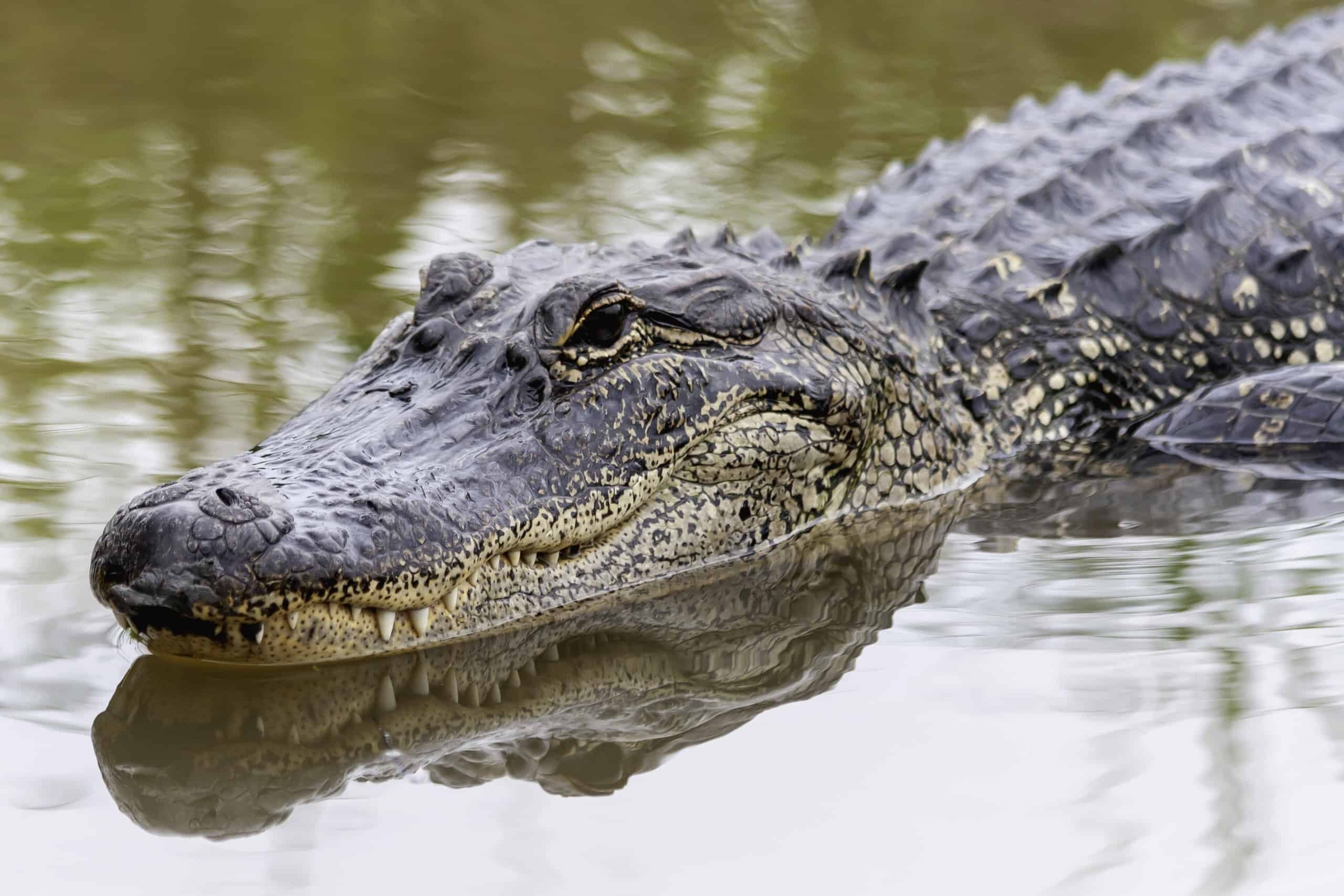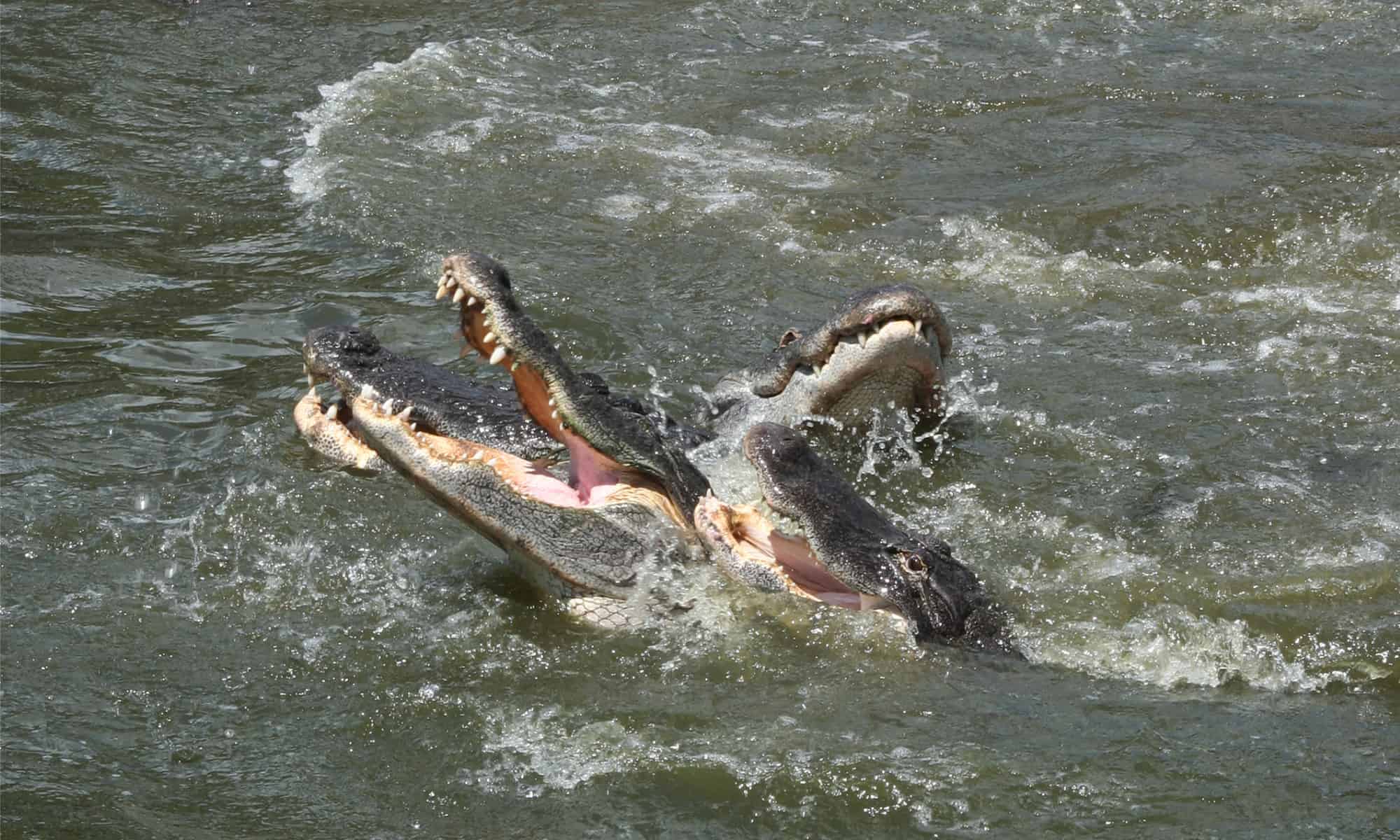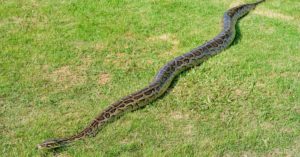Alligators are cold-blooded reptiles that spend most of their time lurking in freshwater lakes, rivers, and ponds. American alligators prefer the warmer climates found in the southeastern United States. While alligators aren’t great at running, they swim at incredibly fast top speeds in the water.
How Fast Can Alligators Swim?
Alligators are impressively fast swimmers and can reach speeds of 20 mph. These reptiles have short legs with partially webbed feet that they can bend while swimming at a relaxed pace. However, a gator’s real power comes from its tails.
To swim fast, alligators tuck their legs against their body and use their heavy, powerful tails to propel them through the water at great speeds, according to the Bataria Preserve.
An alligator can easily outswim a human. Without assistance such as a monofin, humans can only reach speeds of around 5 or 6 mph in the water over short distances. An alligator can even swim faster than a human can paddle a canoe or kayak.

An alligator can reach speeds of up to 20 mph in water.
©iStock.com/Cindy Larson
Alligators Aren’t As Fast on Land
Alligators can be surprisingly fast outside of the water. On land, these creatures can run somewhere between 9.5 and 11 miles per hour. It’s certainly possible for humans to outrun them. The Marathon Handbook calculates the average sprinting speed for adult human athletes (across both genders) to be 18.23 mph.
Furthermore, chasing prey down on land is not an alligator’s MO. Gators tire easily and rarely exert themselves on land for over 100 feet. They’re the most dangerous in the water, or right beside the water’s edge…
Alligators Hunt Use Water To Their Advantage When Hunting
So how do alligators catch prey? Gators might have a reputation for being aggressive hunters, but that really isn’t the truth. These creatures typically hunt by lying in wait until prey approaches. Then they lunge out of the water at speeds of up to 30 mph.
Alligators can even use their tails to push themselves as far as 5 feet. out of the water and snag prey from low-hanging tree branches, according to How Stuff Works.
These reptiles may lie in wait for hours while searching for prey. They often float in shallow water with only their eyes and snout exposed. Alligators also have skin sensors that allow them to detect anything disturbing the water’s surface nearby.
Alligators Use a Hunting Tactic Called the Death Roll
One of the most infamous tactics alligators use to take down prey is sometimes called the “death roll” and it’s as scary as it sounds. Alligators can’t use their teeth to chew their food, and they aren’t great at chasing down prey on land. The death roll helps these animals with both of these problems.
When an alligator lunges and grabs large prey it will typically pull the creature underwater. With the animal gripped in their jaws, alligators roll over and over in the water to disorient their prey. The death roll also serves to rip their prey into bite-sized pieces.

Alligators use a tactic called the “death roll” to take down prey.
©iStock.com/Nigel Stripe
Alligators Can Stay Underwater for Hours
Though alligators spend most of their time in freshwater rivers, lakes, swamps, and marshes, they can’t actually breathe underwater. However, they can hold their breath for quite a long time and are very well adapted to being in the water.
Alligators have flaps that close off their ears and nostrils when they are underwater. They also have a palatal valve in the back of their throat that keeps water out of their throat, stomach, and lungs. Alligators also have two sets of eyelids. Their clear inner eyelids protect their eyes and help them see clearly underwater.
Usually, alligators stay underwater for around 10-20 minutes. In a pinch, however, they can remain submerged for up to two hours. In very cold water they may even stay submerged for up to eight hours.
Alligators Can Go Years Without Eating
Alligators definitely don’t need to eat every day. In fact, these cold-blooded reptiles are typically satisfied with having a meal once a week. Alligators store excess calories in fat deposits at the base of their tale. Due to this, they can go as long as two years without eating.
Alligators typically hunt at night. They have a unique part of their eyes known as the tapetum lucidum or “eye shine.” This structure reflects light back into the photoreceptor cells to help them see in low light and darkness. It also gives gator eyes an eery red glow at night.

Alligators’ eyes have a red glow at night.
©Alexey Stiop/Shutterstock.com
You Can Probably Hold an Alligator’s Mouth Shut
Alligators have been known to attack humans, and their strength and speed in the water make them frightening predators. It’s worth noting, however, that while alligators can bite down with great force, they don’t have much strength when it comes to opening their jaws.
American alligators have a maximum bite force of around 2,980 PSI. However, they have relatively weak jaw-opening muscles, so humans could likely hold an alligator’s mouth shut with just one hand (we don’t recommend trying it though.)
Alligators Are Apex Predators
Alligators are known as apex predators. This means they are at the top of the food chain and have no natural predators of their own. Given an alligator’s speed and strength in the water, it’s no wonder that other animals prefer to keep their distance.
However, just because alligators are apex predators, doesn’t mean other animals haven’t been able to take them down. Big cats like leopards and panthers have been known to kill gators. Large snakes such as giant boa constrictors can also give alligators a run for their money.
Baby alligators face their share of dangers. Large birds may swoop down and kill a baby gator and raccoons have been known to go after gator eggs. Baby alligators may even fall victim to cannibalism from another gator.
Luckily for the babies, mother alligators display a behavior that is rather uncommon for modern reptiles. Mother alligators display protective behavior, guarding their eggs and protecting hatchlings for at least the first year of their lives.
The photo featured at the top of this post is © David Louis Tiffany/Shutterstock.com
Thank you for reading! Have some feedback for us? Contact the AZ Animals editorial team.






